Brussels – Hopes at the end of 2023 become reality in the first days of 2024. The car license plate dispute between Kosovo and Serbia, one of the darkest chapters in the recent history of relations between the two Balkan countries, the original cause of the whole escalation of tension between Pristina and Belgrade that was cause of moments of violence in the past year in northern Kosovo, has been formally closed. A tangible success resulting from the unrelenting mediation of European Union Institutions that – amid controversy over certain shortcomings in the management of a very complex relationship between the two partners – can now rejoice in the positive effects the decision of the Kosovo and Serbian governments will bring on the ground.
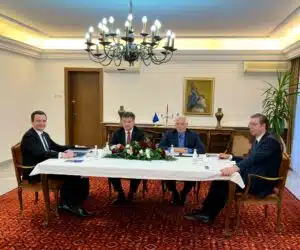
“The EU welcomes the decision of Kosovo and Serbia to formally recognize each other’s license plates and to completely abolish the sticker regime,” said the EU High Representative for Foreign Affairs and Security Policy, Josep Borrell: “This decision represents a positive step in the implementation of the Agreement on the Path of Normalization and past Dialogue commitments made in the framework of the Freedom of Movement,” he added. In 2011, Serbia and Kosovo first agreed to mutually recognize each other’s license plates, thanks to an agreement brokered by the EU during the first year of the Pristina-Belgrade dialogue on the normalization of relations. However, the decision was never fully implemented, and vehicles going from Kosovo into Serbia and vice versa could only cross the border with a special sticker to cover national symbols. Since September 2021, vehicle license plates have become the (first) breaking point for relations between the Kosovo government of Albin Kurti and the Serbian president, Aleksandar Vučić, with the epicenter of tension in northern Kosovo inhabited by a sizeable ethnic Serbian minority.
The Serbian director of the Office for Kosovo, Petar Petković, on December 25, confirmed that from January 1, 2024, all vehicles with license plates from the Republic of Kosovo would be able to cross the border with Serbia freely. On January 5, the Kosovo government announced the same measure, paving the way to resolve the dispute that will have a tangible impact on the everyday lives of citizens of the two Balkan countries. The agreement “demonstrates that it is possible to make progress in the normalization of relations between Kosovo and Serbia” and underscores even more “the importance of continuing to work within the framework of the EU Facilitated Dialogue,” the High Representative Borrell underlined. Not forgetting that this is also “a step in the right direction towards better regional and European integration of the Western Balkans, which ultimately benefits the citizens of the region,” the European diplomacy chief reiterated.
From the license plate dispute to the attack in northern Kosovo
After the two 2021 summer meetings between PM Kurti and President Vučić in Brussels, the license plate dispute broke out for the first time in northern Kosovo in mid-September of 2021. Initially, it was a diplomatic dispute between Pristina and Belgrade related to the Kurti government’s decision to impose the change of license plates on Serbian vehicles entering Kosovo territory, used in large part by the very Serbian minority in the country. EU mediation temporarily resolved the issue. However, with no final solution, tensions erupted in the second half of 2022. In late July, the first roadblocks and barricades by the most extremist ranks of the Serb-Kosovar minority emerged, and two failed meetings between Vučić and Kurti in Brussels led to a continuation of the stalemate.
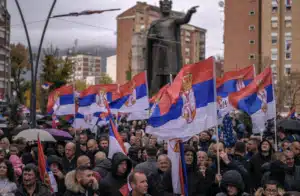
Protests by Serb Kosovars in northern Kosovo Kosovo, Nov. 5, 2022 (credits: Armend Nimani / Afp)
The situation worsened when Lista Sprska took over the reins of the popular protest in northern Kosovo. There was a mass resignation of mayors, councilors, parliamentarians, judges, prosecutors, judicial personnel, and police officers from their respective national institutions on November 5 in protest against the phased-in implementation plan of the Serbian license plate replacement rules. The mayors of Kosovska Mitrovica, Zubin Potok, Zvecan, and Leposavić were among those who stepped down, making it necessary to return to the polls in the four cities: originally scheduled for December 18, they were postponed to April 23. At the same time, on the night between November 23 and 24, a compromise solution on the license plates was reached in Brussels. However, ahead of the December 6 EU-Western Balkans summit in Tirana, Serbian President Vučić threatened to boycott the solution because of the appointment of Nenad Rašić in the Kosovo government (instead of the leader of Lista Srpska, Goran Rakić) as minister for Communities and Returning Refugees. Rašić is the leader of the Democratic Progressive Party, a Serbian formation hostile to Belgrade and a competitor of Lista Srpska.
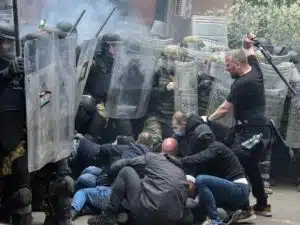
Clashes between Kosovo Serb protesters and NATO Kfor mission soldiers in Zvečan, May 29, 2023 (credits: Stringer / Afp)
2022 ended with a new escalation of tension at border crossings in northern Kosovo after Pristina’s decision to send several hundred police forces to make up for the lack of officers who resigned in November. The barricades of the most extremist Serb-Kosovar ranks were dismantled only after a few weeks thanks to the diplomatic effort of Europe and the U.S. A new crisis erupted on May 26, 2023, as newly elected mayors of Zubin Potok, Zvečan, Leposavić, and Kosovska Mitrovica took office resulting in violent protests caused by Lista Srpska representatives, which turned into guerrilla warfare on May 29 also involving soldiers from the international KFOR mission led by NATO (30 were wounded, including 11 Italians). Tensions exploded over the Kurti government’s decision to force its hand and deploy special police forces to allow mayors elected on April 23 into town halls in a controversial election round: turnout tended to be irrelevant – around 3 percent – because of Lista Srpska’s boycott.
After the deployment in the Balkan country of 700 additional members of the KFOR reserve contingent, new protests erupted in early June over the arrest of two protesters accused of being among those responsible for the violence in late May. At the same time, the arrest/kidnapping of three Kosovar police officers by Serbian security services was staged on June 14, for which the governments of Pristina and Belgrade accused each other’s law enforcement agencies of trespassing, in a border area between northern Kosovo and southern Serbia poorly controlled by Kosovar police and usually used by smugglers to try to avoid border controls. After weeks of unheeded, continued calls for calm and de-escalation, Brussels found it necessary to convene an emergency meeting with PM Kurti and President Vučić to seek viable ways out of “crisis management mode.” On June 22, Serbia released the three Kosovar police officers, but the tensions between Pristina and Belgrade ended up in the conclusions of the June 29-30 European Council.
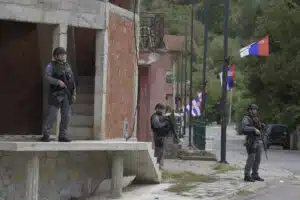
(credits: Armen Nimani / Afp)
Due to Pristina’s failure to take a “constructive attitude” toward de-escalation of tension, Brussels imposed “temporary and reversible” measures against Kosovo in late June, which also included suspending the work of the bodies of the Stabilization and Association Agreement. A four-step roadmap was agreed on July 12 to remove these measures, but they are still in place (as criticized by the Kosovar president, Vjosa Osmani, at the last EU-Western Balkans summit). Within days of an unsuccessful high-level meeting in Brussels, however, the situation between Serbia and Kosovo escalated with the terrorist attack that began in the early hours of September 24, near the Serbian Orthodox monastery in Banjska, when Kosovar police arrived to reports of an illegal checkpoint on the border with Serbia. The officers were attacked from several positions by a group of about 30 men armed with a heavy arsenal of firearms, who, after killing one policeman and wounding two others, entered the monastic complex where pilgrims from the Serbian city of Novi Sad were staying. Clashes continued throughout the day during the “clearing operation,” in which three of the terrorists died.
Post-September 24 developments, however, have painted a much more serious picture than expected, with clear ramifications in neighboring Serbia. As a video filmed by a drone highlights, among the attackers outside the monastery was Radoičić, deputy head of Lista Srpska. While Kosovar police discovered a huge arsenal of weapons and equipment at the terrorists’ disposal, on Friday (September 29), Radoičić himself confirmed that he had led the armed attack, putting the Serb leader on the spot. This confession has cast a long shadow not only over the participation of the Serb-Kosovar leadership in a strategy of destabilizing the country that has potentially been going on for years but, more importantly, over Vučić’s ability to interfere in Pristina’s internal affairs in a more or less covert and violent manner. Adding to this are revelations about the presence also of Bojan Mijailović (one of the three killed bombers), a bodyguard of the head of the Serbian intelligence service, Aleksandar Vulin, and especially of Milorad Jevtić, a close associate of the Serbian president’s son, Danilo Vučić. According to the findings of an investigation by Balkan Insight, in the attack, weapons manufactured in Serbia in 2022 were used, and some mortar shells and grenades were repaired in the Serbian state maintenance centers in 2018 and 2021.
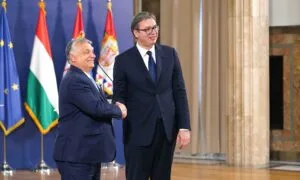
From left: the prime minister of Hungary, Viktor Orbán, and the president of Serbia, Aleksandar Vučić, in Belgrade (July 8, 2021)
Also worsening relations between Kosovo and Serbia was the U.S. warning of a Serbian “major military deployment” along the administrative border with “an unprecedented build-up of advanced artillery, tanks, and mechanized infantry units.” The threat did not materialize — according to PM Kurti, an annexation of northern Kosovo was planned with “a coordinated attack on 37 separate positions” — but the European Union has started to reflect on the possibility of imposing the same measures in force against Pristina also against Belgrade. “We need to make sure that we make the best use of the tools the EU has to encourage both sides to contribute to a solution of the crisis,” EEAS spokesman Peter Stano explained to Eunews. But the green light for the “temporary and reversible” measures against Serbia requires unanimity in the Council and, at the moment, the only veto came from Vučić’s closest ally inside the Union: Hungarian Prime Minister Viktor Orbán, calling the scenario outlined by European officials and shared by the other 26 governments “absurd and ridiculous.”
More insights on the Balkan region in the newsletter BarBalcani hosted by Eunews
English version by the Translation Service of Withub





